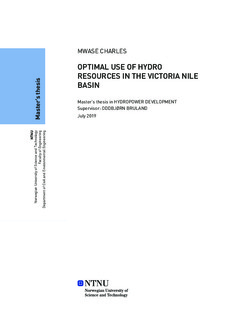| dc.description.abstract | Uganda’s energy demand has been on a steady increase of about eight percent over the past decade and is expected to increase even more in the future. Several micro, small and large hydropower plants have been constructed and more are expected in the future as the country aims at having enough installed capacity to meet future energy demand. Uganda’s energy sector is hydropower dominated with a total installed capacity of 1182 MW as of May 2019. Over 80 percent of Uganda’s hydropower is generated by large hydropower plants which are all located along the upper Victoria Nile river, there by forming a cascade of four power plants consisting of Nalubaale, Kiira, Bujagali and Isimba HPP(s).
As more power plants are constructed along the Victoria Nile river to increase generation capacity, this study was carried out with an objective of optimizing the production from the Upper Victoria Nile river cascade, with a focus on production maximization. The optimization process was carried out using nMAG simulation model as a decision support tool and human judgement. A model of the cascade was set up in nMAG simulation model and different flow scenarios were studied. An operation strategy was established that increased the total production from Nalubaale and Kiira HPP by 6.2 percent on average over the observed period of 10 years. This operation strategy involved operating Nalubaale HPP as a base load power plant at a constant generation of 25.5 MW and Kiira HPP as both base load and peaking power plant for generation of the rest of the power dispatched to the two power plants.
The impact of climate change on future production from the cascade was assessed for the period 2020 to 2059 and indicated an increase in runoff. The increase in runoff lead to increased production from the cascade with Bujagali and Isimba HPP(s) being able to operate at maximum installed capacity for most of the time. | |
